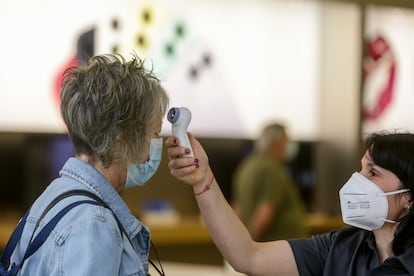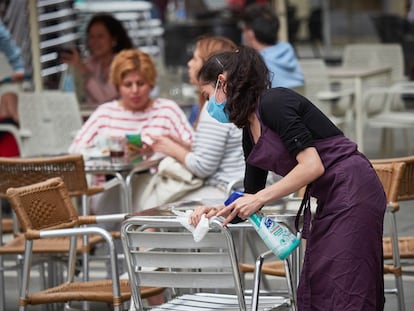Coronavirus confinement measures may have saved 450,000 lives in Spain
New study of 11 European countries concludes that lockdown has had a major effect on reducing transmission of the SARS-CoV-2 virus

Over a century ago, many European and American cities experienced the worst pandemic in recent history. When the first cases of the Spanish flu began emerging in 1918, officials in Saint Louis ordered schools and churches to close, banned street demonstrations and parades, and recommended that people self-quarantine at home.
In Philadelphia, by contrast, nothing was done until several weeks after the first cases were detected. Mortality from the flu was eight times higher there. Or, looking at it the other way around, the leaders of Saint Louis managed to save thousands of lives thanks to quick, decisive action.
A new study published in the journal Nature has calculated how many lives were saved in 11 European countries thanks to confinement policies during the Covid-19 pandemic. Researchers estimate that the measures imposed first in Italy, then in Spain and later in the other countries under analysis may have saved over three million lives – including around 450,000 in Spain.
These figures should be viewed skeptically: they are probably an overestimateMiguel Ángel Martínez-Beneito, Valencia University
The study, called “Estimating the effects of non-pharmaceutical interventions on Covid-19 in Europe” and conducted by a team headed by Imperial College London, focused on Spain, Austria, Belgium, Denmark, France, Germany, Italy, Norway, Sweden, Switzerland and the United Kingdom.
Researchers used the number of deaths in each country to estimate the number of infections around two weeks earlier, and studied their evolution to May 4, when some countries began lifting their lockdowns. The study concluded that “major non-pharmaceutical interventions and lockdowns in particular have had a large effect on reducing transmission.”
In all analyzed countries, the reproduction number – the number of new cases generated by one infected person – fell below one, a value at which it is considered that the virus can no longer expand. Without any measures, experts estimate that there would have been 3.1 million additional deaths in these countries.
“The virus-transmission rate has dropped until it has come under control in all the analyzed countries,” says Shamir Batt, a statistician at Oxford University and co-author of the study. “The main thing now is to assess which measures must remain in place to keep transmission under control.”
Study limitations
This kind of model is controversial because it does not faithfully reproduce the complexity of an evolving pandemic in individual countries, with the differences inherent to each one. In late March, for instance, this same team predicted that 15% of the Spanish population had been infected with the coronavirus. An ongoing large-scale antibody study conducted in Spain places this figure closer to 5.2%.
This time around, the authors posit that 5.5% of the Spanish population has been infected with SARS-CoV-2, putting Spain only behind Belgium, where the figure is around 8%. The countries with the lowest prevalence are Norway (0.46%) and Germany (0.85%).
“These figures should be viewed skeptically: they are probably an overestimate,” warns Miguel Ángel Martínez-Beneito, a biostatistician at Valencia University and main author of the National Atlas of Mortality in Spain, which explores the varying risk of death from 74 causes depending on which part of the country people live in.
“If the infection fatality rate [number of deaths among infected people] in our country is around 1%, this means that the Imperial College’s model gives us nearly 47 million infected people, which is the entire Spanish population,” he adds. “This is impossible, since herd immunity would be achieved with a contagion rate of 60%.”
The authors admit that one of their main limitations is the fact that they rely on official death tallies, which may not be a reliable reflection of the true number of coronavirus-related fatalities. “Amidst the ongoing pandemic, we rely on death data that is incomplete, with systematic biases in reporting, and subject to future consolidation,” warns the study.
“The authors underscore that their estimate of saved lives assumes that only official interventions contributed to lowering the reproduction number,” explains Saúl Ares, a researcher at the National Biotechnology Center of the Higher Scientific Research Council (CSIC). “This is evidently not so; even if no official measures had been taken, at some point people would have locked themselves at home anyway. In fact this was already happening: in our data analysis, we saw from the beginning that the epidemic was spreading at a increasingly lower rate, even before measures were introduced, and that’s because people began being more cautious.”
English version by Susana Urra.
Tu suscripción se está usando en otro dispositivo
¿Quieres añadir otro usuario a tu suscripción?
Si continúas leyendo en este dispositivo, no se podrá leer en el otro.
FlechaTu suscripción se está usando en otro dispositivo y solo puedes acceder a EL PAÍS desde un dispositivo a la vez.
Si quieres compartir tu cuenta, cambia tu suscripción a la modalidad Premium, así podrás añadir otro usuario. Cada uno accederá con su propia cuenta de email, lo que os permitirá personalizar vuestra experiencia en EL PAÍS.
¿Tienes una suscripción de empresa? Accede aquí para contratar más cuentas.
En el caso de no saber quién está usando tu cuenta, te recomendamos cambiar tu contraseña aquí.
Si decides continuar compartiendo tu cuenta, este mensaje se mostrará en tu dispositivo y en el de la otra persona que está usando tu cuenta de forma indefinida, afectando a tu experiencia de lectura. Puedes consultar aquí los términos y condiciones de la suscripción digital.
More information
Últimas noticias
Most viewed
- Pablo Escobar’s hippos: A serious environmental problem, 40 years on
- Reinhard Genzel, Nobel laureate in physics: ‘One-minute videos will never give you the truth’
- Why we lost the habit of sleeping in two segments and how that changed our sense of time
- Charles Dubouloz, mountaineering star, retires at 36 with a farewell tour inspired by Walter Bonatti
- The Florida Keys tourist paradise is besieged by immigration agents: ‘We’ve never seen anything like this’











































